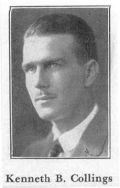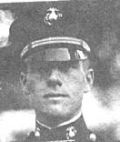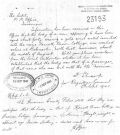Kenneth B. Collings(NY-Wells Agency - now NY-Rubin) Research continues into the fate of four National Life agents who were Killed In Action during World War II. In the case of Collings, three significant research breakthroughs have taken place that reveal new details of his fate. The first breakthrough was the release of materials from the Canadian National Archives, the second was the release of American military records, and the third was direct contact with the man who caused Collings' death! Since childhood, Collings had been a thrill-seeker and, with his success as one of National Life's top agents during the 1930s, he enjoyed the ability to work hard for several months then take time to travel the world in search of adventure. During his travels, he became a part-time correspondent and actually marched with Hitler's troops into Czechoslovakia from where he submitted several articles. Previously, he had sought adventure in Africa and was the only American to get an interview with Emperor Haile Selassie during Italian dictator Mussolini's invasion of Ethiopia. It is unclear exactly when his military career began, but we do know that from June of 1916 until April 1917 Collings was in the Washington, D.C. National Guard prior to America's entry into World War I. On October 11, 1917, he took the oath of office as a new second lieutenant in the Marine Corps. Upon completion of officer's school, he was assigned to the Marine Aero Detachment in Miami, Florida in February of 1918. By March 26, he was "appointed a Naval Aviator for duty involving actual flying in aircraft, including dirigibles, balloons, and airplanes." On July 17, 1918 the first serious adventure of his life began as he departed Hoboken, N.J. aboard the U.S.S. DE KALB as a member of the 1st Marine Aviation Force bound for the battlefields of the Western Front. It is unclear exactly how much aerial combat he saw but the fact remains that he was one of the very few U.S. Marine aviators to serve in France during the First World War. Collings was caught in the great Spanish Influenza Epidemic and was sick from the end of October 1918 until returning to duty two days before the end of the war. He returned to the U.S. on December 9, 1918 and Collings remained in the Marines and the Marine Corps Reserve until retiring in March of 1940. Early in 1941, not content to sit on the sidelines prior to America's entry into World War II, Collings volunteered as a pilot in the Royal Canadian Air Force. His task, as an American volunteer, would have been to shuttle Commonwealth aircraft to North Africa where the British were locked in combat with the German forces of General Erwin Rommel. In 1937 Collings had written a fictional story for Argosy Magazine about piloting a plane to St. Johns, Newfoundland with an undercover federal agent onboard. (During this same year, he also became a founding member and first Junior Vice Commander of the Marine Corps League.) It must have seemed ironic to Collings four years later when he actually arrived in Canada (St. Johns, Newfoundland) where he and five other American pilots boarded the Canadian troopship, S. S. NERISSA. It was April of 1941 and Collings had resigned from National Life, leaving his wife and young son at home so that he could seek adventure in the ever-expanding war. It is hard to imagine why, but the NERISSA was packed with civilians plus a large number of Canadian troops destined for Liverpool. The ship would be sailing on a military mission through waters patrolled by German submarines at a time of war. Much of the story of what happened next came to light when the National Archives of Canada loaned National Life a 16mm microfilm regarding the NERISSA and the Court of Inquiry into its sinking. The NERISSA had previously completed 39 successful crossings of the North Atlantic after the Germans had begun unrestricted submarine warfare. The German U-boats were tasked with sinking any ship that might be sailing in support of the British and the sinking was to be done without warning. (The NERISSA was armed and was a legitimate target under the international rules of war, which makes it even more surprising that women and children were on board.) The NERISSA was regarded as a "lucky ship" since it had made so many successful crossings. At 10:32 p.m. on the night of April 30, 1941 that all changed. German submarine (U-boat) Commander, Lieutenant Erich Topp watched as the NERISSA sailed directly into the crosshairs of his U-boat. At age 27, Topp was the youthful commander of Unterseeboot #552 - generally known as "U-552." On this combat patrol, U-552 had already sent three other British ships to the bottom of the Atlantic. Topp issued the command to fire three of U-552's remaining torpedoes, which struck the NERISSA in rapid succession. Within five minutes, the ship slipped under the waves. Canadian records are in some disarray but it would appear that 207 men, women, and children went down with the ship and 80 survived. Collings survived the massive explosions of the torpedoes but never made it into a lifeboat. Some lifeboats were destroyed in the explosions, others were rendered useless by botched attempts at launching, and others were found to be missing their drainage plugs so that seawater poured into the boats as soon as they were launched. Collings was probably wearing his life jacket but apparently succumbed to hypothermia while pulling a Canadian serviceman to the relative safety of floating debris. After the war, the serviceman personally thanked Collings' widow and said that Collings had saved his life by helping him onto floating wreckage. Although Collings' name wasn't specifically mentioned in the Canadian Court of Inquiry materials, this story is included in those records. Survivors report having been in the frigid water and anxiously looking for the U-boat that fired the fatal torpedoes. They saw nothing. It didn't take long for the cries for help to grow quiet as men, women, and children perished in the cold North Atlantic waters. Lt. Topp survived the war and because he had served honorably as a naval military commander and never with any affiliation to the Nazi party, in 1958 rejoined the West German Navy. Topp retired as a Rear Admiral and had later served time in the Pentagon as a naval representative for the West German government. When contacted in 2002, Topp agreed to help document the sinking of the NERISSA from his viewpoint. He stated that his submarine had been heavily damaged during an earlier depth charge attack. He was en route and nursing his U-boat back to their base in occupied France when they came upon the NERISSA. He was surprised to find the NERISSA with its lights on and not running a zigzag course - it was an easy target. After confirming the successful sinking, and concerned for the safety of his own crew, he chose to continue their journey to France because his U-boat was too damaged to take on any survivors. Topp also knew that Allied warships and aircraft were in the area and was proven right by the early morning arrival of both which picked up the remaining survivors from the NERISSA. Although the date and exact place are now unknown, several weeks later, Collings' remains washed on shore in Scotland and he was buried in a nearby Royal Air Force base cemetery. A special inscription on his wristwatch eventually led to a positive identification of his remains. After the war, his remains were returned to the U.S. and he was buried in Section 34, Grave 3763 at Arlington National Cemetery. After the war, his widow received a phone call from a young lady. The caller said that she wanted to say "thank you" because her fiancee had been saved from drowning by Collings. His heroic efforts had cost Collings his own life. Kenneth Collings wrote two books about his adventurous life. Original copies of "These Things I Saw" and "Just for the Hell of It" are in the National Life archives. He was a gifted writer and each highly readable book tells the details of his adventures in the face of danger. Collings also co-authored "With Allenby in the Holy Land" with his close friend, Lowell Thomas. Thomas was probably America's most famous radio personality in the 1930s and 40s. Upon learning of Collings' death, Thomas devoted his entire evening program on network radio in memory of his close friend. A bronze plaque with the name of Kenneth Brown Collings is permanently on display in the National Life Home Office. Reprinted with permission from the National Life Insurance Company Ref: The National Life Insurance Company - www.nationallife.com/public/histarchive/military_collings.asp
Ref: National Archives BT 381 – 1457.
|

Herb Coles "Remembrance Day" Story Capt. Gilbert Ratcliffe Watson Court of Inquiry & Official Documents Wartime Evacuation and the Children's Overseas Reception Board Memorials - In Honour & Remembrance Location of the Nerissa Sinking using Radio Messages and Co-ordinates
|
|||
|
© 2004 SS Nerissa +++ All rights reserved |
||||


